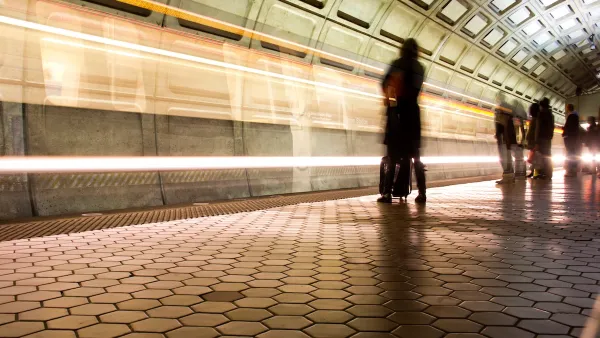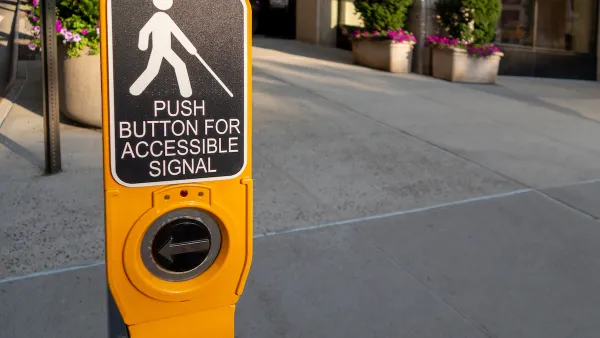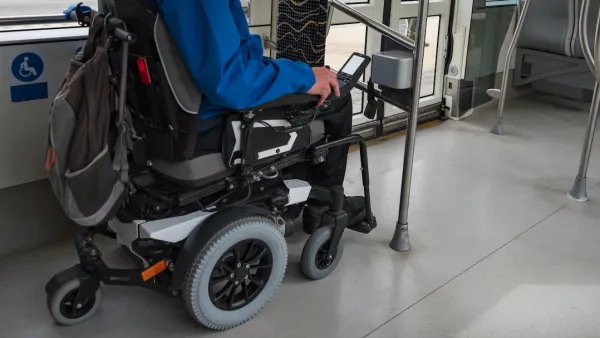Contrary to popular myth, the disabled drive less than other Americans.

One common argument against virtually any policy that might inconvenience drivers is that disabled people cannot walk and thus need to drive, and that pro-pedestrian policies therefore constitute ableism. It seems to me this argument is based on a certain stereotype of disabled Americans: as middle-class car-owning senior citizens whose disability requires a wheelchair, and who never walk, and who cannot rely on public transit. But a 2017 Bureau of Transportation Statistics (BTS) survey shows that this stereotype is inaccurate in a variety of ways.
First of all, the majority of Americans who have a transportation-limiting disability are under 65: out of 25 million Americans with a mobility-related disability, only 11.2 million are over 65. Only 11.6 percent of Americans with mobility-related disabilties (or "MDs" for short) use wheelchairs, about half the percentage of MDs who use walkers (22.9 percent) and one-third the number who use canes (36.7 percent). 42.2 percent of MDs use no medical devices at all to help them get around.
Second, most younger MDs are not middle-class. More than half of under-65 MDs live in households with incomes under $25,000, and only 20 percent of them work at all (as opposed to three-quarters of other Americans under 65). Almost half of this 20 percent (46.8 of them) work part-time. (Because many over-65 Americans are retired, I suspect that transportation-disabled seniors are even less likely to work; however, the study adds no data relevant to this point.)
Not surprisingly, many of these disabled Americans do not drive. Nearly 40 percent of MDs do not drive cars themselves, as opposed to 8.3 percent of nondisabled Americans. Many of these people, of course, live with someone who does drive. Even so, MDs are more likely to be car-free than the rest of us: 22.5 percent of all nonworking MDs under 65 live in households without cars, as do 12.2 percent of the minority of MDs who work. In each of these categories, MDs are more likely to be in zero-vehicle households than nondisabled Americans. For example, only 3.9 percent of non-disabled, employed workers under 65 live in zero-vehicle households.
As a result, MDs are less likely to use cars for most trips than their non-disabled counterparts. Employed MDs under 65 drive themselves on 54.5 percent of trips, while nearly three-quarters of nondisabled workers under 65 do so. Nonworking MDs do so for only 42.6 percent of trips, as opposed to only 58.3 percent of non-disabled unemployed. MDs get rides from other drivers, however, for a little over 1/4 of all their trips (31 percent for nonworkers, 23.5 percent for workers).
Even though many transportation-disabled Americans have difficulty walking, they are still more likely to walk to most trips than the non-disabled. According to BTS, employed MDs "walk for a slightly greater share of trips than workers without disabilities (14.6 v. 13.0 percent)".
Because not all buses and trains comply with the Americans with Disabilities Act, one might think that disabled people are less likely to use public transportation than other Americans. But this is not the case. Employed MDs under 65 use local transit on 4.3 percent of all trips, as opposed to 2.7 percent for their nondisabled counterparts. Similarly, nonworking MDs under 65 use transit for 5.9 percent of all trips, as opposed to 3.3 percent for their nondisabled counterparts. This data does not include paratransit, which is used far less frequently; roughly 1.5 percent of trips by transportation-disabled Americans are on paratransit. Thus, the notion that paratransit is a useful substitute for local transit seems to be incorrect, at least for many disabled Americans.
What about the seniors with mobility impairments? Surely one might think that they drive more than anyone else, since the ability to walk declines with age. This is only partially true: even though senior MDs are driven around more than the younger disabled, they are not significantly more likely to drive than non-disabled seniors. Senior MDs drive themselves for only 47.8 percent of all trips (compared to 69.3 percent for non-disabled seniors).
Senior MDs use public transit less than younger MDs, but they nevertheless do so more than non-disabled seniors: they use local transit for 2.8 percent of all trips, while nondisabled seniors use transit for 1.8 percent of trips. Senior MDs use paratransit less than nonseniors; they only use it for 0.9 percent of all trips—additional evidence that paratransit is not a substitute for traditional public transit.*
In sum, the disabled are less likely to own cars than other Americans, more likely to use buses and trains, and about equally likely to walk. So if we want more equity for the disabled, we should make walking and public transit easier.
*This does not mean that paratransit is unnecessary. The purpose of paratransit is to serve people who cannot use traditional transit- so the minority of disabled who use paratransit really, really need it.

National Parks Layoffs Will Cause Communities to Lose Billions
Thousands of essential park workers were laid off this week, just before the busy spring break season.

Retro-silient?: America’s First “Eco-burb,” The Woodlands Turns 50
A master-planned community north of Houston offers lessons on green infrastructure and resilient design, but falls short of its founder’s lofty affordability and walkability goals.

Delivering for America Plan Will Downgrade Mail Service in at Least 49.5 Percent of Zip Codes
Republican and Democrat lawmakers criticize the plan for its disproportionate negative impact on rural communities.

Test News Post 1
This is a summary

Test News Headline 46
Test for the image on the front page.

Balancing Bombs and Butterflies: How the National Guard Protects a Rare Species
The National Guard at Fort Indiantown Gap uses GIS technology and land management strategies to balance military training with conservation efforts, ensuring the survival of the rare eastern regal fritillary butterfly.
Urban Design for Planners 1: Software Tools
This six-course series explores essential urban design concepts using open source software and equips planners with the tools they need to participate fully in the urban design process.
Planning for Universal Design
Learn the tools for implementing Universal Design in planning regulations.
EMC Planning Group, Inc.
Planetizen
Planetizen
Mpact (formerly Rail~Volution)
Great Falls Development Authority, Inc.
HUDs Office of Policy Development and Research
NYU Wagner Graduate School of Public Service






























